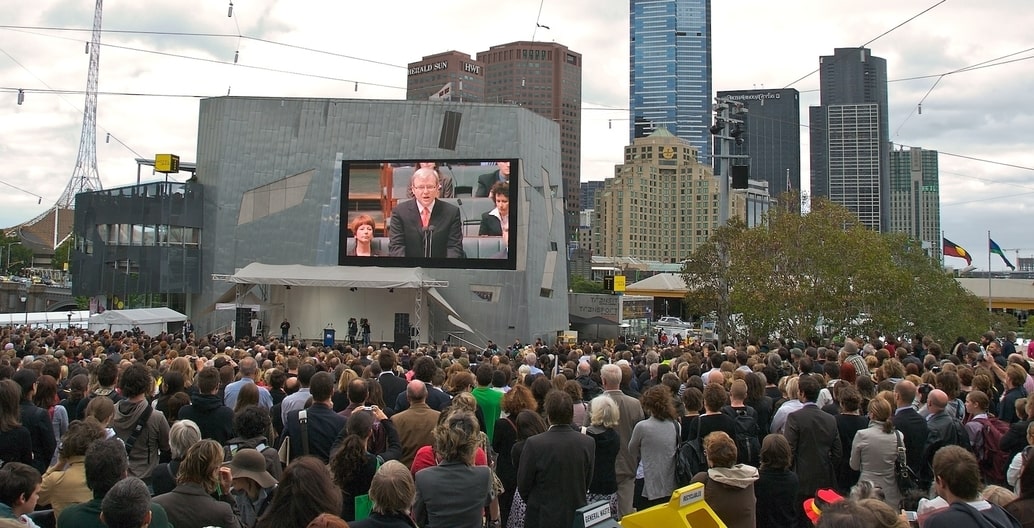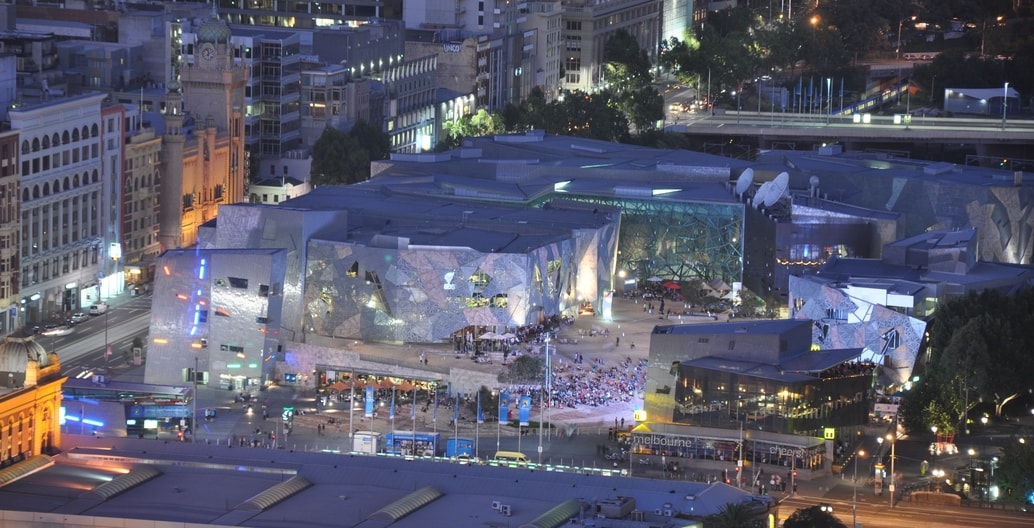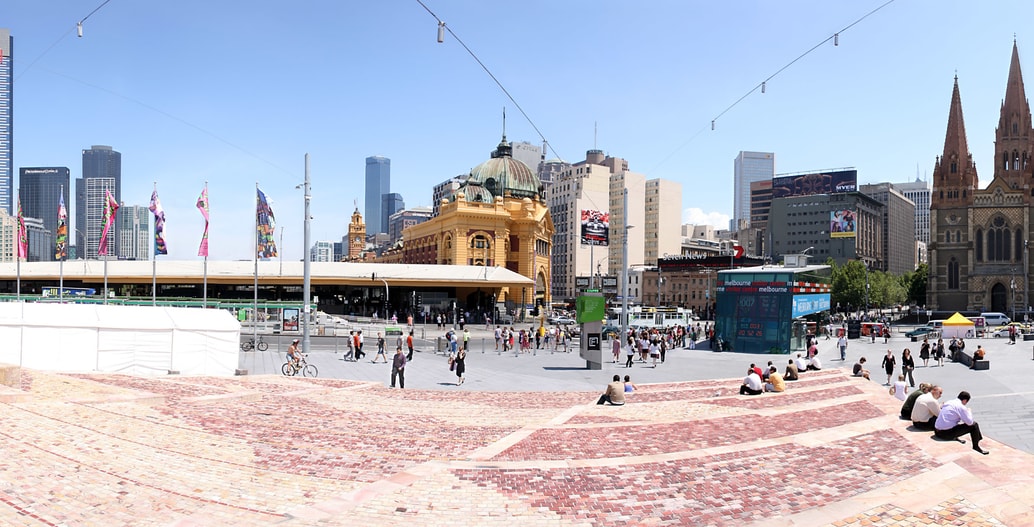
“Public space should not be managed as a business”
Apple’s ambitions for a flagship store in Melbourne’s Federation Square have been quashed – for now. As Citizens for Melbourne note, important questions remain as to what will deliver “appropriate” development of our public spaces in the future.
With Heritage Victoria refusing an application to demolish Federation Square’s Yarra Building, Apple’s plans to build a store in Melbourne’s iconic public square have hit an insurmountable roadblock. But while the Victorian state government says the store can no longer proceed, some wonder if the conditions that allowed the proposal to gain traction in the first place remain.
We speak with Citizens for Melbourne, the group that sprung up to oppose the government’s plans for Fed Square, to explore how Melbourne’s most high profile public place could become co-opted by a global consumer electronics giant – and what might need to change to stop it from happening again.
Foreground: Federation Square is thought of as Melbourne’s public or town square and hosts numerous free public events. Has the Apple proposal exposed how ‘public space’ may operate in the Square, and perhaps elsewhere in our cities?
Citizens for Melbourne: In many ways Fed Square is the public space people expect. We celebrate our city and our culture at Fed Square. We go there to meet friends, we visit arts and cultural institutions such as the Koorie Heritage Trust, the NGV and ACMI, we protest, we cheer for our team and celebrate milestones and events important to our identity as Australians.
What some people might not expect is that the management structure of Fed Square is defined by a corporate structure – Fed Square Pty Ltd. Although this structure sometimes causes confusion as to whether Fed Square is privately owned or publicly owned, Fed Square Pty Ltd is wholly owned by the State Government and by extension, the people of Victoria.
What the Apple proposal has shown us is how important public space is to our cities and our community. It clearly illustrates that definitions of public space change over time in response to our social and cultural values. Public space is socially produced and negotiated at the intersection of public interests, private interests and governance. This means that our understanding of public space is contextual — we understand the public space of Tiananmen Square very differently from Trafalgar Square or even Times Square. This also means we must fight for the public space we want otherwise we will end up with the public space someone else defines for us.
FG: Does the Apple proposal and subsequent controversy reflect wider trends that have monetised the social value of space? Have other cities adopted or resisted these trends?
CfM: Yes. We can see this happening globally. Cities are questioning the role that businesses and advertising play in the public realm. Communities are increasingly concerned about the fact that more and more pseudo-public spaces are being delivered by private companies. These privately-owned spaces look public on the surface, but citizens do not have the same rights in these spaces as they would have in public space. London, for instance, is currently working on the Public London Charter which will “set out both rights and responsibilities for users and owners of public spaces, regardless of whether they are council-run or in the hands of private developers.”
A parallel challenge is that existing public spaces are being infiltrated by large corporations and reworked to project their interests and sell their products. Apple’s global ‘Town Square’ strategy was all about co-opting public space, and Melbourne’s Federation Square was seen as an ideal site in which to implement this strategy. In Stockholm, similarly, Apple sought to place a store in the central Kungsträdgården but was blocked by local authorities.
Apple is not the only firm adopting this type of strategy to expand their footprint into our public spaces. In downtown Toronto, Google plans to develop a waterfront site into a ‘Smart City’, replete with sensors within the infrastructure to track the data of visitors and residents. We need to understand that companies like Google, Amazon, Facebook and Apple are not going away. As such, they have a role to play in our public realm, but governments need to think very carefully about how to balance the interests of business and commerce with public interest.

FG: The need to reverse financial losses or raise more revenue was a key argument supporting the Apple proposal. What evidence is there and how important should financial arguments be?
CfM: Public space should not be managed as a business. Federation Square is too important to be funded under a corporate operating model that does not take into account its wider benefit to the city and the state. It should not need to ‘pay its own way’. We don’t require our magnificent city gardens, cultural institutions or monuments to pay for their own upkeep. The same principle should apply to our city square.
The financial benefits of Fed Square to our city and state vastly outweigh the expense of building, maintaining and running the Square. Economic modelling has been completed for events such as the Melbourne Grand Prix and sporting grand finals as well as for creative industries and arts precincts including the Sydney Opera House. It would be much more productive to look at Fed Square as part of a network of public cultural infrastructure and to fund it accordingly and appropriately.
The benefits demonstrated by broader economic modelling extend beyond the immediate physical boundaries of Federation Square. They include supporting greater liveable densities in the CBD and increasing residential, retail and commercial property values. The Square also contributes to our city’s renowned liveability making Melbourne a more attractive place to live, work and study, and promotes Melbourne as a tourist destination which supports hotels and hospitality businesses. It also clearly supports creative industries through cultural and artistic programming, and builds community resilience by fostering public events that grow community connections and cross-cultural understanding.
FG: Along with financial loss, falling attendance and lack of connection with the Yarra were also mentioned. Did the proposed design address these current deficiencies?
CfM: Federation Square should not be set in stone. Places change, however any change needs to be made thoughtfully, with expert guidance, in consultation with the public and in a way that does not compromise the architectural integrity of Federation Square or its civic and cultural life.
In terms of the connection to the Yarra, the landscaping proposed for the Apple store could have largely been implemented without the need to demolish the Yarra building. However, this is not to suggest that the landscaping design proposed with the Apple store is the right answer. Any design solution addressing this issue should be developed in consultation with key stakeholders including the City of Melbourne and the wider public.
Above and beyond any other use, Fed Square needs to function primarily as a civic square. Visitor numbers, although important, are ancillary to this issue. Federation Square’s buildings were designed deliberately to embrace the public and the buildings shape the civic square as a place for public gathering — spaces which we flow through are more typically associated with retail programming. If increasing the visitor numbers to the Square undermines the Square as a gathering place for the community this would not be an acceptable outcome. Would it not be more fruitful to work on increasing the time people spend at Fed Square? This could be achieved by working to strengthen and encourage forms of retail that facilitate social and cultural interaction – such as restaurants, cafes and galleries – and supporting the provision of compelling public programming that promotes community interaction with the square.
Fed Square needs reflective moments just as it needs active moments. Time spent in the Square watching the world pass by and observing the wonderful mix of people who inhabit it also provides value in our increasingly busy world. The ebb and flow of Fed Square should not be viewed as a ‘failure’ but as part of the rhythmic quality of the Square and of its public life.
Achieving the balance between Fed Square as an access route and Fed Square as public square, while also ensuring adequate visitor numbers to keep this area alive is a real challenge. The planned review offers a rare opportunity to consider these issues in a rational and systematic way without losing sight of the public nature of the place.
FG: Is Federation Square Management Pty Ltd a body that provides the best management model for Federation Square? What key aspects of operation in the precinct that it should handle differently?
CfM: Over the last few years we have seen the prioritisation of commercial activities and promotion over cultural and community-based activities at Fed Square. Managing Federation Square requires a mix of expertise that includes an understanding of arts and culture, events and hospitality, finance and economics, logistics and strategy and design, heritage and architecture. And, this mix of expertise needs to have a laser sharp focus on engaging the community in the public life of the square and reinforcing Fed Square as a place for the people.
We are optimistic that the planned review of Fed Square will identify and define processes and structures that will embed this expertise and focus into a strengthened vision for Fed Square going forward. As our society changes so too will this vision need to evolve and we would hope that any proposed management model would include periodic appraisal of the direction and vision of the Square.

FG: What key considerations would you hope the Review covers?
CfM: Finance and funding, governance and management and the development of a masterplan that addresses design and architecture, a Conservation Management Plan and a Signage, Branding and Advertising policy. We would also like to see the Federation Square Civic and Cultural Charter strengthened as part of this process.
FG: Public consultation will be part of the review. What would you like to see as part of that process?
CfM: We would like to see a broad public consultation process followed by public consultation targeted at specific issues arising from the initial consultation and the review process. In addition, we would like to see public consultation on significant issues and a periodic review strategy that includes public consultation embedded into Federation Square’s governance and management model moving forward.
FG: Is more commercial development of Fed Square still a possibility?
CfM: Potentially, the review could propose conditions to enable future commercial developments which presently cannot proceed. To move forward with these proposals, they would have to be assessed transparently against Fed Square’s civic and cultural objectives (see the Federation Square Civic and Cultural Charter), its heritage significance and developed in consultation with the community.
FG: Heritage Victoria’s Registration Hearings will consider protection for the entire precinct. It must meet at least one of eight assessment criteria. Which criteria does the Square meet?
CfM: We argue that Federation Square meets six of the eight assessment criteria for inclusion on the Victorian Heritage Register:
As the culmination of Victoria’s long search for a town square it is important to the “course, or pattern, of Victoria’s cultural history” (Criterion A), it demonstrates the “principal characteristics of a class of cultural places” as a notable example of a public square (Criterion D) and is an outstanding example of architectural and aesthetic characteristics (Criterion E). Fed Square also demonstrates a “high degree of creative or technical achievement at a particular period” (Criterion H), has a “strong or special association” with the Victorian community (Criterion G) and it is associated with the “life or works of a person, or group of persons, of importance in Victoria’s history” (Criterion H).
FG: Is this recommendation and support for heritage protection unprecedented, given the relative youth of the Square?
CfM: Heritage protection for Federation Square would definitely not be unprecedented. There are several notable examples of places that have been awarded heritage protection despite being relatively young. The National Gallery of Victoria for example, was completed in 1968 and then protected just 14 years later in 1982. The Victorian Arts Centre was constructed between 1973 and 1984 and was not yet fully open when it was included in the Government Buildings Register in 1982.
Another notable example is the Waverley Park stadium in Mulgrave. This building was constructed between 1970 and 1976 and included in the Victorian Heritage Register in 2002.
FG: The Review marks a significant moment for Federation Square and perhaps for Melbourne’s public space. What do you hope for as an outcome for the Square in 2020 and beyond?
CfM: Yes, this is a significant moment not just for Federation Square but for Melbourne’s appreciation of public space and valuing of public rights and institutions. In the face of the 2019 federal election, we find ourselves in a moment where trust in our politicians and our political institutions is at an all-time low. Part of this distrust stems from feelings that our political class is out of step with public concerns and public frustration at the lack of avenues that allow public concerns to be heard in meaningful ways beyond the ever increasing volume of social media.
Processes that truly engage with public consultation — that give people the ability to speak about, and have considered input into, the places that are important to them and their sense of community — will not repair this lack of trust overnight but are part of processes that demonstrate that government is willing to listen.
If nothing else, we hope that both the community and government rise to the challenge to ensure that Federation Square maintains its significance and its value as our well-loved and internationally renowned public square.
–
Foreground spoke with Tania Davidge, Michael Smith and James Lesh of Citizens for Melbourne, a volunteer, non party-political group of architects, urbanists, planners and lovers of public space, arts and culture.


